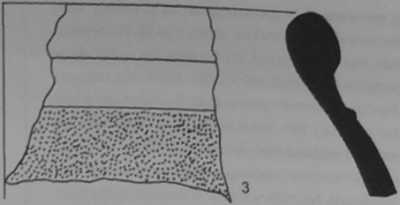S5006673
182 Marek Bednarek

Flfl. 2. RoszowickJ Las. site no. 6. Hand-made pottery from the settlement
noticeably differ, while the group of pit graves has not yielded burials with any significant metal finds. While dis-cusslng burial customs we should also notę the ditched features which have been found situated beside graves. Kietrz has yielded three rectangular and two circular enclosures (Gedl 1984: 157-186) and Nowa Cerekwią another rectangukar example (Bednarek 1993). Such features may be compared to examples found in Central Europę. However, these are not common (Ćiźmar 1973: 622-623).
The chronology of the Upper Sileslan settlements has been discussed many timęs (Wożniak 1970: 90-101; 1981:251-254; 1990:9-17; Meduna 1980:33-34). Mera we may add some notes based on recent research.
As mentioned above, permanent settlement of the La Tśne culture in the area of Upper Silesia occurred at the beginning of LTB1. The oldest occupation, dated by associated brooches, is the settlement at Roszowicki Las, site 6 (Bednarek 1993a: 137). The first buildings at
Nowa Cerekwią are slightly youngęr—they are dated to LTB2. We should mention here an urn grave in a redan-gular ditched feature found within the settlement, and dated by the occurrence of three MOnsingen brooches of type to LTB2. Other excavated settlements — mainly found in assodation with brooches and glass bracelets — can be related to the La Tśne C phase. It should be added that we do hot have currently have any evidence which indicates that La Tśne settlements lasted as late as the beginning of the La Tśne D phase.
Recent excavations have shown that some of the Upper Silesian settlements, including that at Nowa Cerekwią (LT B2 or possibly B1-C2) and that at Roszowicki Las, site 6 (LTB1-C1) were relatiyely long-lasting. Inhabitants of the latter site proceeded to build two farm-steads (sites 11 and 29), as testified by certain pottery forms; the sites were occupled for several generatlons until LTC2 These exąmplęs testify to a period of consl-derable. On the other hand, the settlements of Dzierży-
Lm Tina settloment In Upper Silesia: An outline

Fig. 3. Szonów, slte no. 22.1. 2,4 — wheel-made pottery, 3 — graphite pottery


sławice, Łany and Szonów were occupied for a relatively short period. Pooriy distinguishable occupation layers almost devoid of associated finds or structures, except for sunken-fkx>red and a few other features associated with dwellings deariy differentiate them from the settle-ments at Roszowicki Las and Nowa Cerekwią, which have yielded culture layers rich in finds and evidence of a devełoped and productive forming economy.
We can also dassify Upper Silesian settiements on the basis of their size. On one hand are the sites of Nowa Cerekwią type, that is, settiements with onły a few buil-dings. Based on the results of field survey we can pre-sume that there were some further settiements of similar type in the region (Chochorowski 1980:68. map 1). Single formsteads, however, with morę or less devełoped agn-cultural fadlities predominated in the regional pattern. Independent of the type of settlement frame buildings were the standard form of construction, a feature which matches building techniques in other regions (Meduna 1980: 58. 193-199; Pazda 1992: 122; Wożniak 1970: 206). This construction technique has been recognised from the excavated pattern of wali footings post holes. In addltlon, traces of intemal framework construction are very common; these Indude wedge-shaped impressłons In the daub which filled slots between adjoining beams.
Post holes in the majority of buildings are situated along the central axis, indicating the use of a ridge roof
supported on fbrked beams. Different construction me-thods may have been employed in buildings without post hole construction. This last seems to have been the case mainly with buildings dated to the La Tene C phase and probably to its later stage, as in the case of. a building of over 40 m* on site 29 at Roszowicki Las).
The compad and distind settlement area of Upper Silesia, surrounded by unpopulated regions without traces of any settlement. was not isolated from the neigh-bouring communities to the south and the culturally un-fomdiar and morę remote neighbours to the north. Typi-cal La Tene finds. such as graphite pottery and fine wheel-tumed. sapropelite and glass bracelets. and evi-dence of on-srte metalworking, is similar or even identi-cal to finds from Bohemia and Moravia. The bulk of these, induding all the sapropelite bracelets, arrived in Upper Silesia as the result of trade.
The only differences that can be obsen/ed are with regard to hand-made pottery. The majority of vessels show features unique to Silesia, for exampte. in the treat-ment of their extemai surface which incłudes roughening of a part of the body in a characteristic vein-like pattern. On the other hand there are features which are forelgn to Silesia. An interesting phenomenon has been ob-served in the north-eastem part of our study area where at a certain developmental stage the La TSne popula-tion interacted with a group with markedly different cul-
Wyszukiwarka
Podobne podstrony:
S5006672 180 Marek Bednarek Fig. 1. Upper Silesia. Map of Celtlc sottloment. a — settlements,&n
S5006671 180 Marek Bednarek 180 Marek Bednarek i Fig. 1. Upper Silesia. Map of Ceitic setflement&nbs
56267 S5006670 La Tene settlement in Upper Silesia:An outline Marek Bednarek At the beginning of the
S5006871 ŚLĄSKIE SPRAWOZDANIA ARCHEOLOGICZNE T. 33, s. 43 Wrocław 1992 MAREK BEDNAREK OSADA PRODUKCY
BARBARA FILIPEK GABRIEL NOWAK JACEK SAPA WŁODZIMIERZ OPOKA MAREK BEDNARSKI MAŁGORZATA ZYGMUNTELEMENT
00181 ?d17515ad1b09ad29b923c2e3121477 182 McWilliams considered before implementing any economic co
więcej podobnych podstron